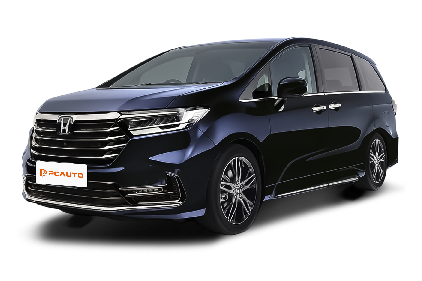Q
Which model of Honda Odyssey is the best?
Which model is the best depends on individual needs and preferences. Both the 2022 and 2018 Odyssey are 7 - seat D - class MPVs. In terms of power, they are both equipped with a 2.4L naturally aspirated engine and a CVT transmission, with a maximum power of 175 horsepower. The official combined fuel consumption is 8.1L/100km for the 2022 model and 8.2L/100km for the 2018 model. In terms of price, the 2022 model costs RM 275,311, while the 2018 model is priced at RM 249,393. In terms of configuration, both models are equipped with various safety systems such as body stability control, as well as comfort features like a multi - function steering wheel. However, the 2022 model has a digital/analog combined dashboard, while the 2018 model has an analog one. The front seats of the 2022 model are electrically adjustable, while for the 2018 model, the driver's seat has 8 - way electric adjustment and the passenger's seat has 4 - way electric adjustment. If you have a limited budget, the 2018 model is a good choice. If you're after newer and more convenient configurations and a better digital experience, the 2022 model is more suitable.
Special Disclaimer: This content is published by users and does not represent the views or position of PCauto.
Related Q&A
Q
How many miles will a 2022 Honda Odyssey last?
The 2022 Honda Odyssey is built to last between 200,000 to 300,000 miles (approx. 320,000 to 480,000 km) with proper maintenance and reasonable use—though actual lifespan depends on driving habits, road conditions, and service frequency.
Power comes from Honda’s proven 3.5L V6 paired with a 10-speed automatic transmission, a combo known for long-term durability. Staying on top of oil changes, transmission fluid, and filter replacements goes a long way in keeping it running smoothly. The chassis and body also feature rust-resistant treatments, making it well-suited to local weather.
Worth noting: The hybrid variant may deliver better fuel efficiency and reduced mechanical wear over time. Stick to factory-recommended service intervals (every 5,000–8,000 km), but shorten them if you frequently haul heavy loads or drive long distances.
While electronics and interior trim typically hold up well for 10+ years, suspension components and rubber seals might need earlier attention. Well-maintained high-mileage Odysseys remain sought-after on the used market—a testament to their reliability.
Q
Is the 2022 Honda Odyssey front or rear wheel drive?
The 2022 Honda Odyssey maintains its front-wheel-drive layout, continuing this model's traditional power delivery approach. Whether equipped with the Earth Dreams 2.4L naturally aspirated engine or hybrid system, all power is channeled through the front wheels—a design that strikes a smart balance between cabin space efficiency and fuel economy.
This FWD setup gives the Odyssey more predictable traction in wet conditions while minimizing mechanical intrusion, freeing up room for its three-row seating and versatile cargo solutions. It's worth noting that while some rivals in the minivan segment offer AWD variants, the Odyssey sticks to front-drive to prioritize ride comfort and serviceability. Its low center of gravity, paired with the CVT transmission, delivers buttery-smooth driving dynamics ideal for family road trips.
For buyers who frequently tackle steep grades or rough terrain, we'd recommend paying extra attention to tire selection and suspension maintenance. That said, the FWD configuration typically keeps maintenance costs more affordable compared to AWD systems.
Q
Does the 2022 Honda Odyssey have a vacuum?
The 2022 Honda Odyssey does come with a built-in vacuum cleaner – a seriously handy feature, especially for families. You'll find it tucked away in the side of the cargo area, powered by the 12V outlet, ready to tackle crumbs in seat crevices or debris on floor mats.
Honestly, it's just one of many thoughtful touches in this minivan. Between the Magic Slide seats, rear entertainment system, and all that clever storage space, Honda's clearly been paying attention to what real families need.
Now don't expect industrial-strength suction – it's no substitute for your household vacuum. But for quick cleanups after soccer practice or road trips with the kids? Absolute game changer. More and more minivans are adding this feature, and you can see why.
Pro tip: Keep the engine running while you use it. These little vacuums can drain your battery faster than a toddler drains your phone battery.
Q
Is there a recall on the Honda Odyssey 2022?
Regarding the recall issue of the 2022 Honda Odyssey, there is currently no extensive record showing that there is a large-scale recall action for this model locally. However, it is recommended that car owners regularly check the latest vehicle safety information through Honda's official website or authorized dealers, as recalls may vary due to differences in regional production batches or component suppliers. Recall is usually an active repair service initiated by manufacturers for specific safety hazards, such as electronic system failures, airbag issues, or component defects. Car owners can verify the status in the brand system with their vehicle identification number (VIN). During daily maintenance, dealers will also update recall information and provide free repairs. For household MPVs like Odyssey, in addition to paying attention to recalls, it is also important to regularly check the brake system, tire wear, and stability of onboard electronic devices. Due to their high space utilization and heavy load requirements, the wear and tear on the chassis and suspension components may be more significant. If any abnormalities are found (such as dashboard warning lights on or abnormal driving experience), it is necessary to contact after-sales service in a timely manner instead of handling them on your own to ensure compliance with safety standards.
Q
What is the battery problem in the Honda Odyssey 2022?
Some owners of the 2022 Honda Odyssey have reported issues with rapid battery depletion, typically manifested as the vehicle being unable to start after being parked for several days, which is mainly related to abnormal discharge of the 12V lead-acid battery. This issue may be caused by continuous power consumption of in car electronic devices, battery management system software logic, or the quality of the battery itself, especially in Malaysia's hot and humid climate, which can accelerate battery aging. It is recommended that car owners regularly check the health status of the battery. When parked for a long time, the negative terminal can be disconnected or a charger can be used for maintenance. If frequent power loss occurs, the vehicle should promptly go to an authorized service center to detect parasitic currents or upgrade relevant control module software. For hybrid vehicles, it is also necessary to pay attention to the collaborative working logic between high-voltage power batteries and 12V auxiliary batteries. This type of composite power system has higher requirements for battery management. You can develop the habit of reducing the use of entertainment equipment after turning off the engine, and choose batteries that meet the original factory specifications for replacement. In hot areas, it is recommended to check battery performance every 2-3 years, as high temperatures can shorten battery life by about 30%. If encountering startup difficulties, try to jump start first and pay attention to recording the frequency of faults to help technicians diagnose faster.
Q
How much is a battery for a 2022 Honda Odyssey?
The battery price for the 2022 Honda Odyssey varies depending on the type, brand, and where you buy it. An OEM battery typically costs between RM800 to RM1,500, while third-party replacements can range from RM500 to RM1,000—factors like capacity, cold cranking amps (CCA), and warranty play a role here.
Stick to batteries that meet the original specs, especially for a tech-heavy ride like the Odyssey. A weak battery can mess with its electronics. Most batteries last 2 to 5 years, so if you notice slow starts or dim headlights, get it checked ASAP.
When shopping, don’t just focus on price—check the warranty too. Some brands offer 1-2 years of coverage, which can save you money down the road. Pro tip: Keep the terminals clean and avoid frequent short trips to squeeze more life out of your battery.
Q
How much does a 2022 Honda Odyssey cost?
The 2022 Honda Odyssey is priced between RM 200,000 and RM 250,000 in the local market, depending on the variant and optional extras. Higher-spec models, for instance, come with more premium features like power sliding doors, leather upholstery, and an upgraded sound system.
This MPV is a hit with families thanks to its spacious 7-seat layout, versatile seating configurations, and impressive fuel efficiency. It’s powered by either a smooth 2.4L i-VTEC engine or a hybrid system, both delivering a comfortable ride.
Safety is another strong point—the Odyssey comes standard with Honda SENSING, which includes adaptive cruise control, lane-keeping assist, and automatic emergency braking. That makes it a solid pick for buyers who prioritize practicality and safety.
If you’re on a tighter budget, there are other options in the segment, but the Odyssey stands out for its clever space management and proven reliability. It also holds its value well in the used-car market, so long-term ownership costs are pretty reasonable.
Q
Does a 2022 Honda Odyssey have a timing belt?
The 2022 Honda Odyssey uses a timing chain instead of a timing belt. This design offers better durability and lower maintenance costs—typically, it doesn’t require regular replacements like a timing belt and can last the engine's lifetime with proper care. Made of metal, timing chains handle heat and wear better than rubber timing belts, though they tend to be slightly noisier.
While many newer vehicles now favor timing chains, some budget models still use timing belts to cut costs. To confirm which type your vehicle has, check the owner’s manual or consult an authorized service center.
One thing to note: Even though timing chains last longer, neglecting oil changes can lead to sludge buildup, potentially affecting the chain tensioner. So, sticking to quality oil changes is crucial. If you hear unusual metallic noises from the engine bay, get the timing system checked ASAP—catching issues early can prevent serious engine damage.
Q
Does the 2022 Honda Odyssey have transmission problems?
As an automotive editor, here's what I can share about the 2022 Honda Odyssey's transmission: There haven't been widespread reports of serious transmission issues with this model. Honda's Earth Dreams 10-speed automatic transmission generally performs well in terms of smoothness and reliability, with clear shift logic during daily driving. That said, some owners have noticed occasional mild hesitation during low-speed operation - nothing outside normal tolerances for this type of transmission.
Durability largely depends on proper maintenance. We recommend changing the transmission fluid every 40,000 km using only OEM-specified fluid. The transmission pairs particularly well with the 3.5L V6, delivering strong power without sacrificing fuel efficiency.
For used buyers: Pay special attention to service records and watch for warning signs like delayed shifting or unusual noises. Pro tip: Using manual mode occasionally helps reduce carbon buildup and extends clutch life.
Q
What is the recall on the Honda Odyssey 2022?
The 2022 Honda Odyssey was subject to a global safety recall addressing two potential issues. First, some vehicles had second-row outboard seat belts that might not have been properly secured during assembly, posing a risk of reduced effectiveness in a crash. Second, certain models exhibited a software glitch in the power tailgate control module that could cause the hatch to close automatically without the usual warning chime, creating a pinch hazard.
Authorized Honda dealers will perform complimentary repairs, which include inspecting and reinforcing seat belt anchor points, along with updating the tailgate control software. Such proactive recalls demonstrate the manufacturer's commitment to rigorous safety standards. Owners can check if their vehicle is affected by entering the VIN on Honda’s official website.
Staying informed about recall notices is a critical part of vehicle safety. If you notice any warning lights or unusual behavior, we recommend contacting your local dealership for a professional inspection—after all, preventive maintenance is always smarter than reactive repairs when it comes to keeping your family safe on the road.
Popular Cars
Model Year
Car Compare
Car Photo
Latest Q&A
Q
How much does it cost to buy a 2024 Tesla Model 3?
The 2024 Tesla Model 3 starts at around RM 175,000, but the final price depends on your chosen configuration and add-ons. Opt for the Long Range or Performance version, and you’re looking at a higher tag.
As Tesla’s entry-level model, it packs cutting-edge EV tech, including 500+ km of range on a single charge and standard Autopilot for both daily commutes and road trips. Just keep in mind extra costs like insurance, registration, and potential home charger installation.
Tesla’s Supercharger network is expanding locally, with solid coverage in major cities, making charging hassle-free. Maintenance costs? Typically lower than gas cars—no oil changes, fewer moving parts—so long-term savings add up.
If you’re after more thrills, the Performance variant hits 0-100 km/h in roughly 3 seconds. Plus, government EV tax perks help soften the upfront cost.
Q
How reliable is the 2024 Model 3?
The 2024 Model 3 delivers solid reliability, thanks to Tesla’s continuous software updates and hardware refinements. Key areas like the battery management system and Autopilot have seen multiple optimizations, leading to a noticeable drop in failure rates.
This model features a stiffer body structure and an improved suspension setup, offering a smoother ride. Upgraded interior materials also help reduce cabin rattles—a common gripe with earlier builds.
EV maintenance costs remain low (no oil changes, etc.), though it’s wise to periodically check battery health and charging components for long-term performance. For shoppers eyeing EVs, charging infrastructure and home charging options matter—thankfully, public chargers are expanding fast, making daily use more convenient.
If you frequently road-trip, planning charging stops ahead helps. While the range easily handles daily drives, a little route prep goes a long way in maximizing the experience.
Q
What is the battery range of the Tesla Model 3 2025?
The battery range of Tesla Model 3 2025 is expected to be optimized based on existing models, and specific data needs to be released officially. However, referring to the EPA range of the 2024 rear wheel drive version, which is about 438 kilometers, and the high-performance version, which is about 513 kilometers, the 2025 model may further improve, especially in terms of battery technology or energy efficiency management. For electric vehicles, the range is greatly affected by driving habits, road conditions, and climate. Air conditioning may slightly reduce the range in hot weather, but the battery thermal management system can usually maintain stable performance. In terms of charging, Model 3 supports super fast charging, which can replenish about 250 kilometers of range in about 15 minutes, while home charging stations require 6-8 hours to fully charge. Daily commuting or long-distance travel are practical enough, it is recommended to follow Tesla's official website or local showroom for the latest information.
Q
Is the 2024 Model 3 worth the price?
The 2024 Model 3 strikes an impressive balance between price and performance. Its upgraded range, more refined interior, and enhanced autonomous driving features genuinely boost its competitiveness—especially for tech-savvy, eco-conscious buyers.
Tesla optimized the battery efficiency this time around, making it suitable for both daily commutes and longer trips, while the handling stays true to the brand’s signature responsiveness. If your budget allows and you’re open to EVs, this one’s worth considering—though a test drive is wise to see if it matches your driving style.
That said, local charging access matters. While public chargers are becoming more common, home installation costs should factor into your budget. Alternatives in this price range exist, so cross-shop specs and service policies (like warranty coverage or charging network support) to make a well-rounded decision.
Q
How many miles does a 2024 Tesla Model 3 get?
The 2024 Tesla Model 3 offers varying range figures depending on configuration. The rear-wheel-drive (RWD) version delivers an EPA-estimated 272 miles (approx. 438 km), while the all-wheel-drive Long Range model pushes that to around 341 miles (roughly 549 km). Real-world range may vary slightly based on driving style, road conditions, and climate.
As a pure EV, the Model 3 achieves this efficiency thanks to its advanced battery management system and lightweight design. It also supports fast charging—at a Tesla Supercharger, you can add up to 200 km of range in about 15 minutes. Whether for daily commutes or longer trips, that’s more than enough for most drivers, especially with charging infrastructure becoming more widespread.
If you need to maximize range, tweaking your driving mode or using the car’s built-in energy optimization features can help squeeze out even more miles.
View MoreRelated News

Honda and Red Bull's eight-year partnership comes to an end. Honda will start a collaboration with Aston Martin.
JamesDec 10, 2025

Additional features without extra cost! Honda City RS series upgraded, equipped with a 360° Surround View Camera System
Kevin WongDec 9, 2025

A brand new Honda Prelude is expected to arrive in Malaysia by 2026, featuring the same hybrid system as the Civic.
MichaelDec 8, 2025

Honda Prelude priced as high as $42,000, which makes me nostalgic for the old Prelude
JamesNov 20, 2025

Honda expects the S2000 to make a comeback, but it is too unique to be revived.
WilliamNov 19, 2025
View More













 Cars
Cars




Pros
Cons